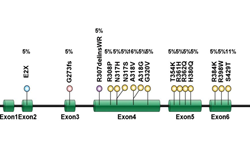GATA2 mutant variant allele frequency may reflect prognosis in Chinese adult patients with de novo cytogenetically normal acute myeloid leukemia
DOI:
https://doi.org/10.17305/bb.2024.10244Keywords:
Acute myeloid leukemia (AML), GATA binding protein 2 (GATA2) gene, variant allele frequency (VAF), prognosisAbstract
Exploration of variant allele frequency (VAF) of GATA2 mutations (GATA2mut) provides insights into acute myeloid leukemia (AML)
prognosis. In this study, we analyzed GATA2mut and co-mutations in 166 Chinese patients with cytogenetically normal AML. This was done through targeted next-generation sequencing of 34 genes associated with myeloid leukemia. GATA2mut was identified in 17 (10%) patients being significantly correlated with co-mutations in CCAAT/enhancer-binding protein alpha (CEBPA) double mutation (P = 0.001). We observed that the N-terminal zinc finger domain (ZF1) was linked to CEBPA mutations, while the C-terminal zinc finger domain (ZF2) was associated with Wilms' tumor 1 (WT1) mutations. It was also noted that patients with GATA2mut had lower platelet counts at diagnosis (P = 0.032). In the entire cohort, GATA2mut had no significant prognostic impact on overall survival (OS) (P = 0.762) and relapse-free survival (RFS) (P = 0.369) compared to patients with GATA2wt. The OS (P = 0.737) and RFS (P = 0.894) of the ZF1 mutation were similar to those of the ZF2 mutation. Most patients with GATA2 mutations were classified in the ELN2022 favorable- and intermediate-risk groups. GATA2mut patients in the favorable-risk group were divided into GATA2High and GATA2Low groups using a median cutoff variant allele frequency (VAF) of 40.13%. GATA2High patients were associated with worse OS (P = 0.031) and RFS (P = 0.021) than GATA2Low patients. In the intermediate-risk group, the high median VAF of GATA2 (≥38.51%) had no significant effect in OS and RFS compared with the low median VAF (<38.51%). This study offers new insights on the prognosis of GATA2mut in the favorable-risk group, where VAF can be used as a guide.
Citations
Downloads

Downloads
Published
Data Availability Statement
Data presented in this study are available on request from the corresponding author.
Issue
Section
Categories
License
Copyright (c) 2024 Huanying Ren, Minglin Hong, Jingyi Feng, Zhuanghui Hao, Xian Chen, Fengting Liang, Wei Wei, Xuelan Liang, Hongwei Wang, Xiuhua Chen

This work is licensed under a Creative Commons Attribution 4.0 International License.
How to Cite
Accepted 2024-02-16
Published 2024-02-27









